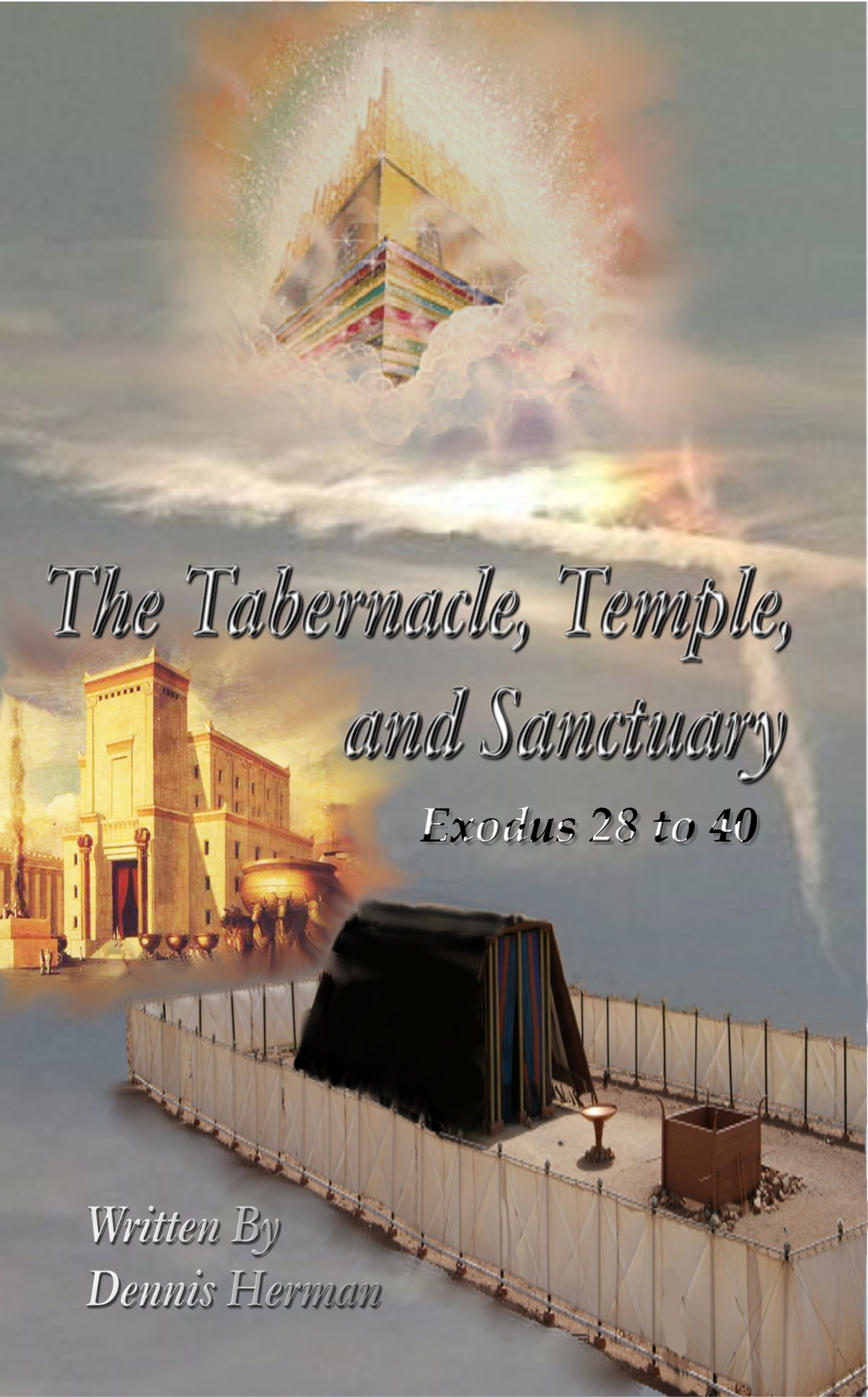Items Inside the Tabernacle
Exodus 37:1-9 NLTse Next Bezalel made the Ark of acacia wood–a sacred chest 45 inches long, 27 inches wide, and 27 inches high. (2) He overlaid it inside and outside with pure gold, and he ran a molding of gold all around it. (3) He cast four gold rings and attached them to its four feet, two rings on each side. (4) Then he made poles from acacia wood and overlaid them with gold. (5) He inserted the poles into the rings at the sides of the Ark to carry it. (6) Then he made the Ark’s cover–the place of atonement–from pure gold. It was 45 inches long and 27 inches wide. (7) He made two cherubim from hammered gold and placed them on the two ends of the atonement cover. (8) He molded the cherubim on each end of the atonement cover, making it all of one piece of gold. (9) The cherubim faced each other and looked down on the atonement cover. With their wings spread above it, they protected it.
 After passing by a number of texts telling us, Bezalel build this item and that item, and how he had help, I had to sit down and pray about this one. Why did Moses repeat details about the Tabernacle? There had to be a reason. A spiritual reason.
After passing by a number of texts telling us, Bezalel build this item and that item, and how he had help, I had to sit down and pray about this one. Why did Moses repeat details about the Tabernacle? There had to be a reason. A spiritual reason.
I had to pray about that for more than a week. Here is the lesson. We have to wait for the right time for God to answer. What better time to explain this detail than while we are looking at the description of the Ark. How much more personal and direct could this be? The answer was so simple and surprising.
To understand, all we need to do is compare the two events Moses recorded and look at the differences. We’ve already seen the similarities in a previous chapter. Now it’s time to look at the differences.
The first time, God explained all the details to Moses while he was on God’s mountain. God personally explained all the details to Moses who recorded them exactly as he was directed. This brings to mind a few verses in Isaiah. In the last days, the mountain of the LORD’s house will be the highest of all– the most important place on earth. It will be raised above the other hills, and people from all over the world will stream there to worship. People from many nations will come and say, “Come, let us go up to the mountain of the LORD, to the house of Jacob’s God. There he will teach us his ways, and we will walk in his paths.” For the LORD’s teaching will go out from Zion; his word will go out from Jerusalem. (Isaiah 2:2-3 NLTse).
Isiah told us people will go to God’s mountain to learn. They will tell more people to go to God’s mountain to learn. Moses explained this process when he recorded details in the Tabernacle the second time.

Moses wrote five books, Exodus is one of them. Exodus consists of forty chapters. Not a very long book at all. But Moses used a number of chapters to record details about the Tabernacle then repeated those details. Moses is not wasting his time or valuable space in his short book. Moses is revealing valuable spiritual lessons.
The second time Moses recorded details in the Tabernacle, he began by telling us how all the people were touched by God’s Spirit. They gave more material than what was required, and volunteered to work on the Tabernacle. But Moses only recorded one name, Bezalel, and kept repeating his name over and over. We know this is not God’s usual style of communicating with us. It’s rare to see God give credit to one person. When we see something unusual, it is time to pay attention.
Moses focused on an individual and repeated that detail more than enough times to catch our attention. God also explained all the details and how each item was constructed to an individual, Moses. God set up something for us to consider. Are we going to look at the Tabernacle like a tour group, quickly passing by only observing the overall plan, view, and understanding of each item, restricted by one person’s brief explanation of each item and the overall view of the design? Or are we going to take time to learn about and view each item like Bezalel?
We have to look back at what we’ve been told about Bezalel. Then Moses told the people of Israel, “The LORD has specifically chosen Bezalel son of Uri, grandson of Hur, of the tribe of Judah. The LORD has filled Bezalel with the Spirit of God, giving him great wisdom, ability, and expertise in all kinds of crafts. He is a master craftsman, expert in working with gold, silver, and bronze. He is skilled in engraving and mounting gemstones and in carving wood. He is a master at every craft. And the LORD has given both him and Oholiab son of Ahisamach, of the tribe of Dan, the ability to teach their skills to others. The LORD has given them special skills as engravers, designers, embroiderers in blue, purple, and scarlet thread on fine linen cloth, and weavers. They excel as craftsmen and as designers. (Exodus 35:30-35 NLTse).
We remember how God gave Bezalel all the gifts he needed to complete the project. Bezalel was given skills to do all the work involved. He was also given skills to teach people. Bezalel also was given wisdom to understand the design. Those are some of the most important features of a true follower of God.
What good is it to collect a bunch of information from God but not be able to teach it? What good is it to have a really great relationship with God if you can’t explain the process, God’s original plan or design? Those are attributes showing the difference between a godly person and a wannabe leader. The real thing will be like Bezalel. They will not only be given skills to complete the project, God will make them complete by providing skills to understand the process and explain it to people.
 There is a world of difference between looking at a concept of the Ark and understanding how each piece is fabricated and assembled. The same is true on a spiritual basis. Seeing only a overall spiritual view of the Ark is not at all like understanding details each piece represents and how they all fit together. Can we explain them now? Not at this point in this study. We can only look back and not much information was given to tell us what each piece represented. We have to be satisfied with what we’ve been given so far.
There is a world of difference between looking at a concept of the Ark and understanding how each piece is fabricated and assembled. The same is true on a spiritual basis. Seeing only a overall spiritual view of the Ark is not at all like understanding details each piece represents and how they all fit together. Can we explain them now? Not at this point in this study. We can only look back and not much information was given to tell us what each piece represented. We have to be satisfied with what we’ve been given so far.
The main point is, learning those details is a personal experience with God. Jesus covered that concept when He promised to teach His disciples how to understand scripture. Then Jesus asked them, “Would anyone light a lamp and then put it under a basket or under a bed? Of course not! A lamp is placed on a stand, where its light will shine. For everything that is hidden will eventually be brought into the open, and every secret will be brought to light. Anyone with ears to hear should listen and understand.” Then he added, “Pay close attention to what you hear. The closer you listen, the more understanding you will be given–and you will receive even more. To those who listen to my teaching, more understanding will be given. But for those who are not listening, even what little understanding they have will be taken away from them.” (Mark 4:21-25 NLTse).
We see Jesus taught the same process. There isn’t a lot of understanding in a quick explanation and overall view. Understanding has a process you have to follow. What you do with that understanding or information is the key. Jesus told us, we’ll see all kinds of information like this lesson about Bezalel and his relationship with the Tabernacle. This information is available to everyone willing to listen. Now here is the key. The closer you listen, the more understanding you will be given–and you will receive even more. To those who listen to my teaching, more understanding will be given.
Do you see how Bezalel is a good example and how his example works with Jesus’ explanation of understanding? What would have happened if Bezalel received all those gifts, skills, and information from God, but didn’t teach and explain it to people? Then why does modern Christianity make a living from providing limited, overall views on subjects, and have no idea how to explain the details, or teach skills to get there. I am referring to the personal experience with God we all should have and share.
If Moses received a view and explanation of all those details on God’s mountain, God had to deliver that information to Bezalel in much the same way. Moses represented God’s physical mountain. Bezalel represented God’s spiritual mountain. Now we understand all those specific orders God gave to allow only people He called up to the physical mountain to approach. They were physical witnesses to His physical mountain that pointed to God’s spiritual mountain. It’s not by accident God spoke His law from that physical mountain and reveled this information at this time, at the description of the Ark. There is a connection to understanding, teaching, seeing details in the design, and God’s law.
It would be redundant to go over the same details in previous chapters. Moses did a good job of repeating details of all the items in the Tabernacle and we’ve seen one of the reasons why. We have to keep in mind, God is still in a state of mind, He wanted to reject Israel because they decided to make their own religion rather than follow Him. That’s a problem we still see today.
I have no idea what level your at or where you are in your walk with God. Since we’ve been shown the learning process is a personal matter between you and God, we have to accept that for what it is. We’ve been shown a number of attributes Moses taught about the priesthood that serves God. All of these details come together like the items in the Tabernacle. Each of them serve a specific purpose as well as reveal portions of God’s personality. Learning those details is not much different that learning about a person during dating stages. After all, that is the goal, to develop a personal relationship with God. You would never trust anyone to tell you details about the person your dating. Why would you trust anyone to give you details about the God offering you eternal life and His Son willing to forgive your sins?
